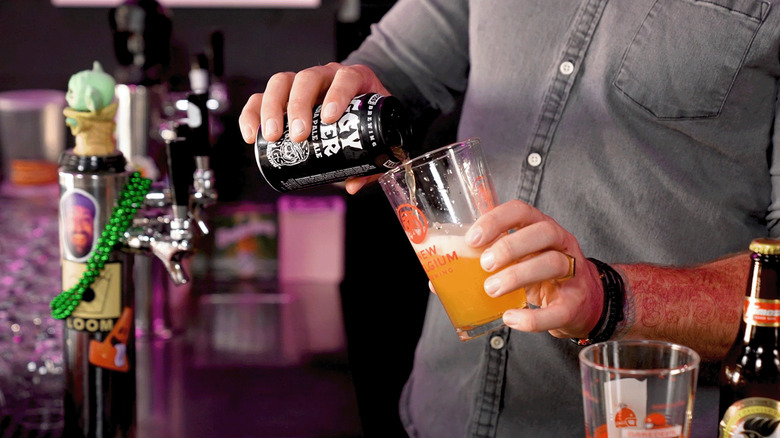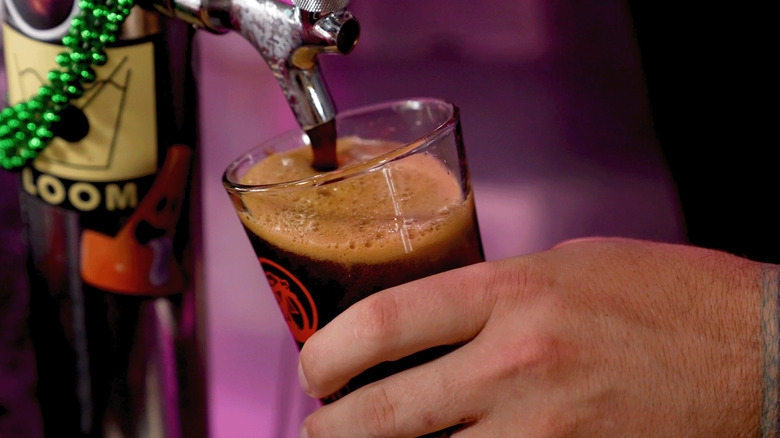How To Pour A Beer - You're Doing It Wrong All Wrong
Pouring a beer might seem like a pretty straightforward task, but there are quite a few factors to consider in order to really nail it. Are you pouring from a can, bottle, or draft line? Will you be drinking out of a pint glass or a tulip glass? What's the carbonation level of the beer and what's the optimal level of foam or "head" you want on top?
In this "You're Doing It All Wrong" video, Chowhound craft bartender Kamaron Lockwood tackles all of these questions as he showcases exactly how to pour a beer, no matter the method. And the good news? You don't have to be a master bartender to get it right.
Regardless of what kind of beer you're pouring — or from what vessel — there are a couple ground rules to follow. Make sure to rinse out your glassware before beginning your pour. This will get rid of any particles or dirt that could interfere with the formation of the head, and it will lubricate the inside of the glass to ensure a smooth pour, Lockwood explains. For those pouring from a draft line, be sure to do a once over and check that the pressure levels are appropriate for the type of beer being served.
Pouring from a can or a bottle
The technique for pouring a beer from a can versus a bottle is very similar, although it may vary slightly depending on the type of beer and level of carbonation. Typically, you'll hold the glass at about a 45-degree angle and pour the beer down the side at an even, steady rate, with an eye on the head to make sure it's not developing too quickly. You'll slowly bring the glass back level as you finish the pour.
A bottle pour will follow largely the same steps. "Depending on the type of beer, you might be able to pour it a little bit faster or slower, especially depending on the carbonation levels," Lockwood says. "I tend to think that a lager and a pilsner ... they don't produce as much of a head as a pale ale or just a regular IPA. I think that it tends to be a little bit more forgiving."
When pouring a bottle of beer that might naturally have a smaller foam head, you can also hold the glass level and pour the liquid down the far side of the glass. The additional friction from the pour can help to create more carbon dioxide bubbles, and thus, more of a head on the beer.
Draft lines 101
Pouring from a draft line into a pint glass can require a bit more know-how and specific knowledge about the particular line itself, as well as a good grasp on the carbonation levels of different ales. Some draft lines can be finicky and others you've just got to get a feel for. In general, using the same 45-degree angle technique and pouring down the side of the glass works well, adjusting the speed of the tap as needed as the head forms and gradually bringing the glass upright as you finish off the pour.
You may opt for a tulip glass, which is a 12-ounce vessel with a rounded bottom and flared rim on top, for more aromatic beers like IPAs, sours, or Belgian ales. "For the right type of beer, it can really enhance the experience, especially in the way it traps the flavor," Lockwood says. When pouring into a tulip glass from a draft line, begin with the same 45-degree angle as before, but you'll need to overfill it in order to push out some of the head that is created. Once the pour is complete, the head will settle. Lockwood recommends keeping a squeeze bottle of water nearby when pouring from a draft line. Since this method often sloshes some liquid down the outside of the glass, a squirt of water cleans it off easily and quickly.
When you rinse out your glassware in advance, choose your angle carefully, and adjust your speed to match the beer's carbonation, you'll have yourself a perfect pour every time.

